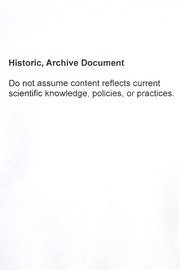
Sensitive plants of the Malheur, Ochoco, Umatilla, and the Wallowa-Whitman National Forests / by Paula J. Brooks ... [et. al.] PDF
Preview Sensitive plants of the Malheur, Ochoco, Umatilla, and the Wallowa-Whitman National Forests / by Paula J. Brooks ... [et. al.]
Historic, Archive Document Do not assume content reflects current scientific knowledge, policies, or practices. t # Sensitive Plants of the Malheur, Ochoco, Umatilla, and the Wallowa-Whitman National Forests 4 U.S. OfcPT OP mkh NATIONAL AGfficm Ti I 4 By CATALOG if-. Paula J. Brooks Karl Urban Eugene Yates Charles G. Johnson, Jr. 1991 USDA - Forest Service Pacific Northwest Region t R6-WAW-TP-027-91 JUL 1991 c c c c c ACKNOWLbLMjc«vii_NTS Quality close-up photography of plants is needed for a publication of this kind. It is difficult to have high quality pictures of sensitive plants that are often scarce or located in remote areas. The capability of an individu¬ al to visit known populations of our sensitive plants at the right time for floral photographic purposes is extremely limited. Therefore, we have solicited photography from various contributing photographers. Credits are extended beside each photo used. We are grateful to the following contributors: Paula Brooks Charlie Johnson Cal Burt Julie Kierstead Joe Duft Peter Lesica Jean Findley Greg Lind Nancy Fredricks Robert Meinke Stu Garrett Karl Urban Douglas Henderson Carolyn Wright Bonnie Hiedel Eugene Yates Bill Hopkins During the months of preparation of this publication we have consulted with many to help provide the most accurate information to the users of this guide. The following people were consulted and gladly gave of their time and knowledge: Kenton L. Chambers Robert J. Meinke Lisa Croft Robert K. Moseley Nancy Fredricks Jean L. Siddall Bill Hopkins Martin K. Stein Jimmy Kagan Susan Vrilakas Greg Lind David H. Wagner Christine C. Lorain Berta Youtie Word processing help was provided by Kathy Hottle and Sherry Nelson. Ail drawings have been used with permission from: Vascular Plants of the Pacific Northwest, by Hitchcock, et al (1955, 1959, 1961, 1964, and 1969). Except: Artemisia ludoviciana ssp. estesii, and Thelypodium eucosmum (detail of fruit); by Eugene Yates, unpublished, used with per¬ mission of the artist. Calochortus longebarbatus var. peckii, by Linda Vorobik; from Threatened and Endangered Vascular Plants of Oregon: An Illustrated Guide. U.S. Fish and Wildlife Sen/ice, Portland, OR. 1982. Lomatium erythrocarpum, from Bulletin of the Torrey Botanical Club, Vol. Ill, No. 2, June 1984. Mimulus hymenophyllus, by Linda Vorobik, from Madrono, Vol. 30, No. 3, July 1983. Leptodactylon pungens subsp. hazeliae, from Madrono, Vol. 35, No. 2, 1988. INTRODUCTION The purpose of this plant identification guide is to provide a ready field reference for assisting in the determination that a particular plant is of a sensitive species. The guide is written to provide comparisons with similar species that "look like" the sensitive species. It is hoped that this guide will forestall the need to pack floras with wider ranges of coverage in daily field activities by the resource manager, specialist or crew mem¬ ber. The guide is not the ultimate authority, however. District and Forest botanists, ecologists, and botanical specialists should be consulted rela¬ tive to proper identification of specimens. The guide is loose-leaf to enable the Forests to delete or add pages as changes occur. The Forests can add supplemental non-published pages dealing with location information, watch list species and other information which changes on an annual basis. We urge the Forests to add collecting help information and to provide procedural information when a sensitive plant or population is encountered. Photographs are missing for some plants. This emphasizes the need to include photography of sensitive plants and to submit copies of 35mm slides or negatives of color prints to the Forest or District botanists. Color prints can then be made for insertion into this guide where pictures are lacking. The key features differentiating the sensitive plant species from other "look-alike" species are highlighted on the line drawing page. ) I » ( ( ( < ♦
